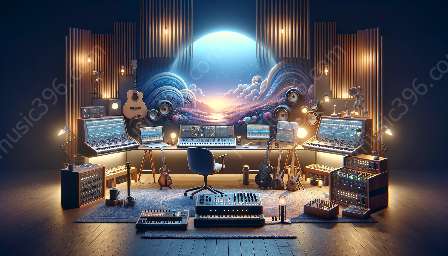Music and sound play a crucial role in film and multimedia. Whether it's setting the mood, creating tension, or enhancing the overall viewing experience, the right musical accompaniment can make a significant difference. In the modern entertainment industry, MIDI (Musical Instrument Digital Interface) has become an invaluable tool for composers, musicians, and sound designers. This article will delve into the multifaceted world of MIDI and its impact on the creation of music and sound effects in film and multimedia, examining its compatibility with music notation and electronic musical instruments.
The Evolution of MIDI
Before we delve into its application in film and multimedia, it's essential to understand what MIDI is and how it has evolved over the years. MIDI is a technical standard that allows electronic musical instruments, computers, and other equipment to communicate with each other. It was first introduced in the early 1980s as a means of standardizing communication between different electronic musical instruments from various manufacturers.
One of the defining features of MIDI is its ability to transmit musical performance data, such as note values, velocity, pitch, and duration, between compatible devices. This enables musicians and composers to record, edit, and play back musical performances with a high degree of precision and flexibility. Over the years, MIDI has continued to evolve, incorporating new features and capabilities that have expanded its applications beyond traditional music composition and performance.
MIDI and Music Notation
One area where MIDI has made a significant impact is in the realm of music notation. Music notation software, such as Sibelius and Finale, have integrated MIDI capabilities, allowing composers and arrangers to input, edit, and playback musical scores with ease. MIDI data can be used to drive virtual instruments, enabling composers to audition their compositions and make necessary adjustments before finalizing the notated scores.
Additionally, MIDI has streamlined the process of creating orchestral mock-ups, where composers use MIDI data to generate realistic-sounding representations of orchestral arrangements. This has proven invaluable in the film and multimedia industry, where tight production schedules often demand efficient workflows for composing and arranging music for large-scale projects. Furthermore, the integration of MIDI with music notation software has facilitated the seamless exchange of musical ideas between composers, performers, and producers, leading to more efficient collaborative processes.
MIDI in Film and Multimedia
When it comes to the use of MIDI in film and multimedia, its versatility shines. From creating atmospheric soundscapes to scoring epic action sequences, MIDI has become an essential tool for composers and sound designers. MIDI controllers, such as keyboard and pad controllers, provide intuitive and expressive ways to manipulate virtual instruments and trigger sound effects, making them indispensable for live performance and studio production alike.
Moreover, MIDI's ability to control a wide range of parameters, such as dynamics, articulation, and effects, has empowered composers to craft highly nuanced and evocative musical compositions. This is particularly evident in the realm of film scoring, where the ability to convey subtle emotions and underscore dramatic moments through music is paramount. Composers can leverage MIDI to create complex musical arrangements that seamlessly sync with the visual narrative, heightening the emotional impact of cinematic storytelling.
MIDI and Electronic Musical Instruments
Electronic musical instruments, including synthesizers, drum machines, and samplers, have greatly benefited from MIDI integration. By adhering to the MIDI standard, these instruments can communicate and synchronize with each other, as well as with computers and recording equipment. This interconnectedness has revolutionized the way musicians and sound designers approach the creation of electronic music and sound effects for film and multimedia.
Furthermore, the widespread adoption of MIDI has led to the development of advanced performance techniques and expressive capabilities in electronic musical instruments. For instance, MIDI controllers such as breath controllers and expression pedals enable musicians to infuse their performances with a level of nuance and subtlety that was previously exclusive to acoustic instruments. This has expanded the sonic palette available to composers and sound designers, allowing for the exploration of innovative and unconventional soundscapes in audiovisual storytelling.
The Future of MIDI in Entertainment
As technology continues to advance, the role of MIDI in film and multimedia is poised to evolve further. With the advent of immersive audio formats such as Dolby Atmos and VR/360-degree audio, MIDI stands to play a pivotal role in shaping the future of audio production for immersive media experiences. The ability of MIDI to precisely control spatial parameters, such as panning, distance, and reverberation, positions it as a key element in the creation of lifelike and immersive soundscapes that complement the visual spectacle of modern entertainment.
Moreover, as new interfaces and control devices emerge, MIDI is likely to adapt and expand its capabilities, offering creative professionals even more ways to manipulate and shape music and sound in the context of film and multimedia. Whether it's through gestural control, haptic feedback, or AI-assisted composition, MIDI's potential for innovation remains a driving force in the pursuit of elevating the auditory component of storytelling.
Conclusion
In conclusion, MIDI's impact in film and multimedia is profound and multifaceted. Its integration with music notation, electronic musical instruments, and a wide array of production tools has redefined the way music and sound are conceived and realized in the entertainment industry. As the boundaries of audiovisual storytelling continue to expand, MIDI's adaptability and versatility ensure that it will remain a cornerstone of innovation and creativity in the realm of sound design, composition, and audio production.


